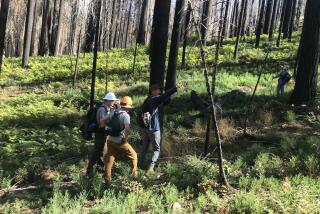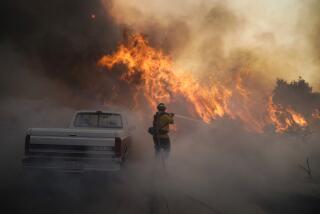The Rim fire and the folly of sequestration

Even as the Rim fire in and around Yosemite National Park rages on, the U.S. Forest Service already has exhausted its firefighting budget for the year, which had been reduced by sequestration cuts. Not that the agency will stop fighting wildfires, but overtime and hiring will be trimmed. This isn’t a sane fire policy for an era of climate change, which is predicted to cause drier conditions in the Western United States and already has expanded the length of the fire season.
At about 150,000 acres and counting, the Rim fire hasn’t made major inroads on the park, but it has burned vast expanses of adjacent forest and treasured recreational land. Despite this blaze and wildfires this summer in Arizona, Colorado and Idaho, 2013 isn’t a particularly bad fire year so far, with 3.4 million acres burned nationwide. It’s worth remembering, though, that we haven’t yet reached the traditional peak of the fire season.
Sequestration is bad policy for many reasons, but if lawmakers are foolish enough to engage in it, they should at least recognize that firefighting is a basic public safety service that should be exempt. Since 1960, there have been only six years during which wildfires burned more than 8 million acres, and all of those occurred since 2004, according to the National Interagency Fire Center.
At the same time, the Forest Service should use its budget wisely by not attempting to fight every single wildfire. By monitoring rather than immediately fighting blazes in remote areas, where communities aren’t threatened, federal land managers will have more money available to fight fires like the one threatening Yosemite. This is sound environmental practice as well. Though fire is a destructive and dangerous force to homeowners and businesses, it is a natural part of the wild landscape, clearing out dead vegetation and too-thick growth, fertilizing soil for plants to regenerate and creating new habitat for animals.
By contrast, aggressively suppressing fires early allows forests to become denser; when they do burn, they have more fuel and burn faster and hotter as a result. That’s part of what has made the Rim fire spread so quickly.
States and municipalities also must change some of their policies, particularly those that have allowed too much construction abutting wild lands. The agencies that allow this dangerous sprawl aren’t generally the ones that pay for it. When fire breaks out on open land, it’s usually the federal government’s responsibility to fight the blaze in order to protect the homes, and to provide disaster aid afterward. Given the predictions of longer, more disastrous fire seasons to come, that’s an unsustainable equation.
More to Read
A cure for the common opinion
Get thought-provoking perspectives with our weekly newsletter.
You may occasionally receive promotional content from the Los Angeles Times.






